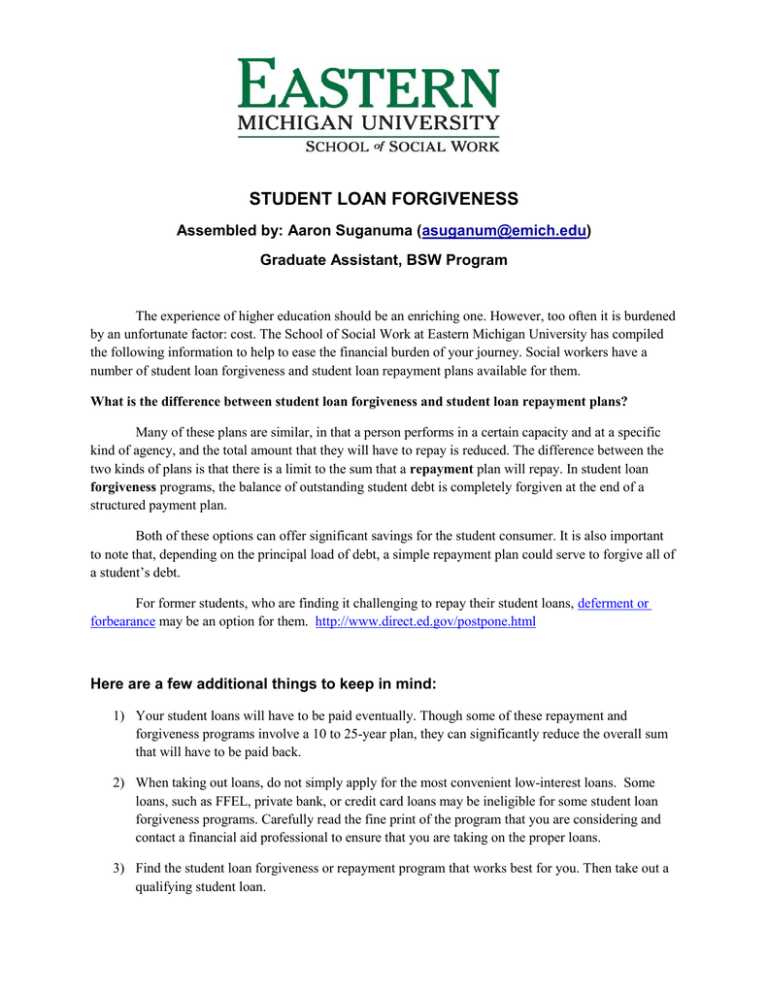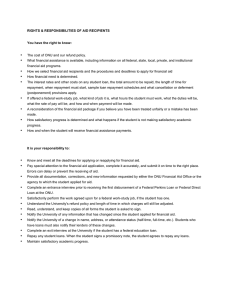STUDENT LOAN FORGIVENESS ( )
advertisement

STUDENT LOAN FORGIVENESS Assembled by: Aaron Suganuma (asuganum@emich.edu) Graduate Assistant, BSW Program The experience of higher education should be an enriching one. However, too often it is burdened by an unfortunate factor: cost. The School of Social Work at Eastern Michigan University has compiled the following information to help to ease the financial burden of your journey. Social workers have a number of student loan forgiveness and student loan repayment plans available for them. What is the difference between student loan forgiveness and student loan repayment plans? Many of these plans are similar, in that a person performs in a certain capacity and at a specific kind of agency, and the total amount that they will have to repay is reduced. The difference between the two kinds of plans is that there is a limit to the sum that a repayment plan will repay. In student loan forgiveness programs, the balance of outstanding student debt is completely forgiven at the end of a structured payment plan. Both of these options can offer significant savings for the student consumer. It is also important to note that, depending on the principal load of debt, a simple repayment plan could serve to forgive all of a student’s debt. For former students, who are finding it challenging to repay their student loans, deferment or forbearance may be an option for them. http://www.direct.ed.gov/postpone.html Here are a few additional things to keep in mind: 1) Your student loans will have to be paid eventually. Though some of these repayment and forgiveness programs involve a 10 to 25-year plan, they can significantly reduce the overall sum that will have to be paid back. 2) When taking out loans, do not simply apply for the most convenient low-interest loans. Some loans, such as FFEL, private bank, or credit card loans may be ineligible for some student loan forgiveness programs. Carefully read the fine print of the program that you are considering and contact a financial aid professional to ensure that you are taking on the proper loans. 3) Find the student loan forgiveness or repayment program that works best for you. Then take out a qualifying student loan. 4) Do not get involved with a debt consolidation company without thoroughly researching them first. This should include visiting their page on the Better Business Bureau and reading reviews of their services on sites other than their own. http://www.loanconsolidation.ed.gov/ is the link to the government-offered program. Be sure to talk to a financial aid specialist before consolidating, to ensure that you are not disqualifying yourself from any possible grace periods. 5) Student loan forgiveness and repayment programs are offered for free by governmental agencies. Do not pay for these services! 6) Be thorough. Call the program’s contact number with any questions you have. Confirm that you are qualified, aware of important deadlines, and not missing any required documentation. 7) Direct.edu.gov created this calculator that can help you to forecast the ways that different repayment plans may benefit you: http://www.direct.ed.gov/calc.html 8) Many programs target HPSA workers. What is that? http://hpsafind.hrsa.gov/ What Stage Are You At? This website has important information, based on where you are in your schooling: Applying: http://www.direct.ed.gov/applying.html While in-school: http://www.direct.ed.gov/inschool.html Graduating, leaving, or dropping below half-time: http://www.direct.ed.gov/leaving.html Loan Forgiveness and Repayment Programs: 1. Public Service Loan Forgiveness Program (PSLF) The PSLF program is designed to ease the burden of the traditional 25 year loan forgiveness timeline. In this program, the borrower finds the payment method that works best for their income and specialty. Under this program, a 10 year, or 120-month payment schedule is planned. At the end of that plan, the balance of the student loan is forgiven. To learn more about the program, follow: http://www.ibrinfo.org/what.vp.html#pslf To learn more about eligibility, follow: http://studentaid.ed.gov/repay-loans/forgiveness-cancellation/charts/public-service *** Income-Based Repayment (IBR) can be a very attractive way to make your federal student loan payments more manageable when utilizing the PSLF. If you're a teacher, work in government, or at a nonprofit (501(c)(3)) organization, you might qualify for this type of payment method. Qualifying students can significantly adjust their payment plan based on their post-graduate income. This video provides a simple explanation of the program: http://www.youtube.com/watch?v=SpJhC-2i6gI To learn more about this forgiveness program, follow: http://www.ibrinfo.org/what.vp.html To learn more about eligibility: http://studentaid.ed.gov/repay-loans/understand/plans/income-based 2. National Health Service Corps Up to $50,000 for two years of full time service or four years of half time service can be forgiven. Jobs that qualify are described here: http://hpsafind.hrsa.gov/ The NHSC LRP is administered by the Bureau of Clinician Recruitment and Service and is under the umbrella of the Department of Health and Human Services. The NHSC LRP seeks primary care physicians, nurse practitioners, certified nurse-midwives, physician assistants, dentists, dental hygienists, and behavioral and mental health providers (health service psychologists, licensed clinical social workers, marriage and family therapists, psychiatric nurse specialists, and licensed professional counselors) to provide culturally competent, interdisciplinary primary health care services to underserved populations located in selected Health Professional Shortage Areas (HPSAs). In addition to loan repayment, these clinicians receive a competitive salary, some tax relief benefits, and a chance to have a significant impact on a community. This FAQ may answer many of your questions: http://nhsc.hrsa.gov/currentmembers/loanrepaymentrecipients/faqs/index.html The annual application process is outlined here: http://nhsc.hrsa.gov/loanrepayment/applicationprocess/index.html 3. Michigan State Loan Repayment Program The State of Michigan offers a loan discharge program for HPSA workers, including Masters-level Social Workers. For program eligibility and information: http://www.michigan.gov/mdch/0,1607,7-1322945_40012-135399--,00.html. 4. AmeriCorps and PeaceCorps also have partial-forgiveness, full-forgiveness, and grants available for individuals who volunteer in their programs. These positions may also offer a stipend in addition to debt reduction. More general information can be found at: http://www.finaid.org/loans/forgiveness.phtml AmericCorps information can be found at: http://www.nationalservice.gov/programs/americorps PeaceCorps information can be found here: http://www.peacecorps.gov/ 5. Income Contingent Repayment (ICR)- http://www.finaid.org/loans/icr.phtml The ICR plan is designed to make repaying education loans easier for students who intend to pursue jobs with lower salaries, such as careers in public service. It does this by pegging the monthly payments to the borrower's income, family size, and total amount borrowed. The monthly payment amount is adjusted annually, based on changes in annual income and family size. This program is structured around a 25-year repayment plan. Follow this link for more information about the application process: http://studentaid.ed.gov/repay-loans/understand/plans/income-contingent 6. Perkins Loan Forgiveness Program- http://www.naswoh.org/?209 The Perkins Loan Forgiveness Program includes provisions for social workers working in public or private nonprofit child or family service agencies providing services to high-risk children and families from low-income communities or social workers providing early intervention services to infants and toddlers with disabilities in public or private nonprofit agencies under IDEA (Individuals with Disabilities Education Act). This program is also available for teachers, nurses, law enforcement professionals. Recipients of Federal Perkins Loan funds received after July 22, 1992 can qualify for postponement/ cancellation of up to 100% of the loan. The cancellation takes place over 5 years. For each year of service completed, the student is entitled to cancellation of the loan at the following rates: First and second years of employment: 15% each year Third and fourth years of employment: 20% each year Fifth year of employment: 30%. See Child and Family Services Cancellation: http://www.ifap.ed.gov/fsahandbook/attachments/0910FSAHbkVol6Ch5Oct2.pdf Studentaid.gov has assembled the following information for FFEL, Direct Loans, and Perkins Loans: http://studentaid.ed.gov/repay-loans/forgiveness-cancellation/charts There are benefits and disadvantages to including a Perkins Loan in a Federal Direct Consolidation Loan: http://www.finaid.org/loans/publicservice.phtml 7. National Institutes of Health (NIH) *This option is for BSW and MSW students who plan on earning a doctoral degree. The following link provides eligibility information: http://www.lrp.nih.gov/eligibility/eligibility_of_individuals.aspx NIH will repay your student loans for assisting their research efforts. That is the idea behind the National Institutes of Health Loan Repayment Programs (LRPs). The NIH encourages outstanding health professionals to pursue careers in biomedical, behavioral, social, and clinical research. If you commit at least two years to conducting qualified research funded by a domestic nonprofit organization or U.S. federal, state, or local government entity, NIH may repay up to $35,000 of your qualified student loan debt per year, including most undergraduate, graduate, and medical school loans. Loan repayment benefits are in addition to the institutional salary you receive for your research. http://www.lrp.nih.gov/about_the_programs/index.aspx Loan Forgiveness Resources: 1) Direct.ed.gov created this calculator for several repayment options: http://www.direct.ed.gov/calc.html 2) Saltmoney.org created “ 60+ Ways…” as a comprehensive resource for locating and understanding loan forgiveness programs. The resource includes much of the information listed above, including resources for states other than Michigan. https://www.saltmoney.org/Assets/PDFs/60-ways-to-get-rid-of-your-student-loans-withoutpaying-them.pdf 3) Have some basic questions about student loans? Here are some facts, provided by Studentaid.gov. Studentaid.gov is an excellent resource for finding basic information about the process of taking out student loans. https://studentaid.ed.gov/sites/default/files/your-federal-student-loans_1.pdf 4) The Educational Credit Management Corporation resource outlines many of the programs listed above. However, it also sheds light on some other options, such as joining the military and has a link to a student loan cost calculator: http://www.ecmc.org/details/loanForgiveness.html#need 5) There are several advocacy groups who specialize in student debt reduction. These groups, including the Project on Student debt reduction can a great source for pending legislation and the latest tips. http://wwwprojectonstudentdebt.org/ 6) Equal Justice Works is also very active when it comes to education on student debt. View one of their prerecorded webinars for a breakdown of the kind of loans that qualify for certain repayment plans. http://equaljusticeworks.org/ed-debt 7) The Huffington Post also put together this resource: http://www.huffingtonpost.com/2013/09/27/student-loan-forgiveness-guide_n_4002065.html 8) USA Today has a helpful glossary of common loan terminology: http://college.usatoday.com/2013/09/09/student-loans-a-demystified-glossary/ Important: Let’s help each other! If you come across a link that doesn’t work or feel that any information listed on this page is no longer accurate, please let us know. Additionally, if you are aware of any programs not listed, we are working hard to reduce debt. Your input could mean real relief for another person. Thank you, in advance! Contact: Aaron Suganuma, BSW Graduate Assistant, BSW Program School of Social Work, 302G Marshall asuganum@emich.edu


